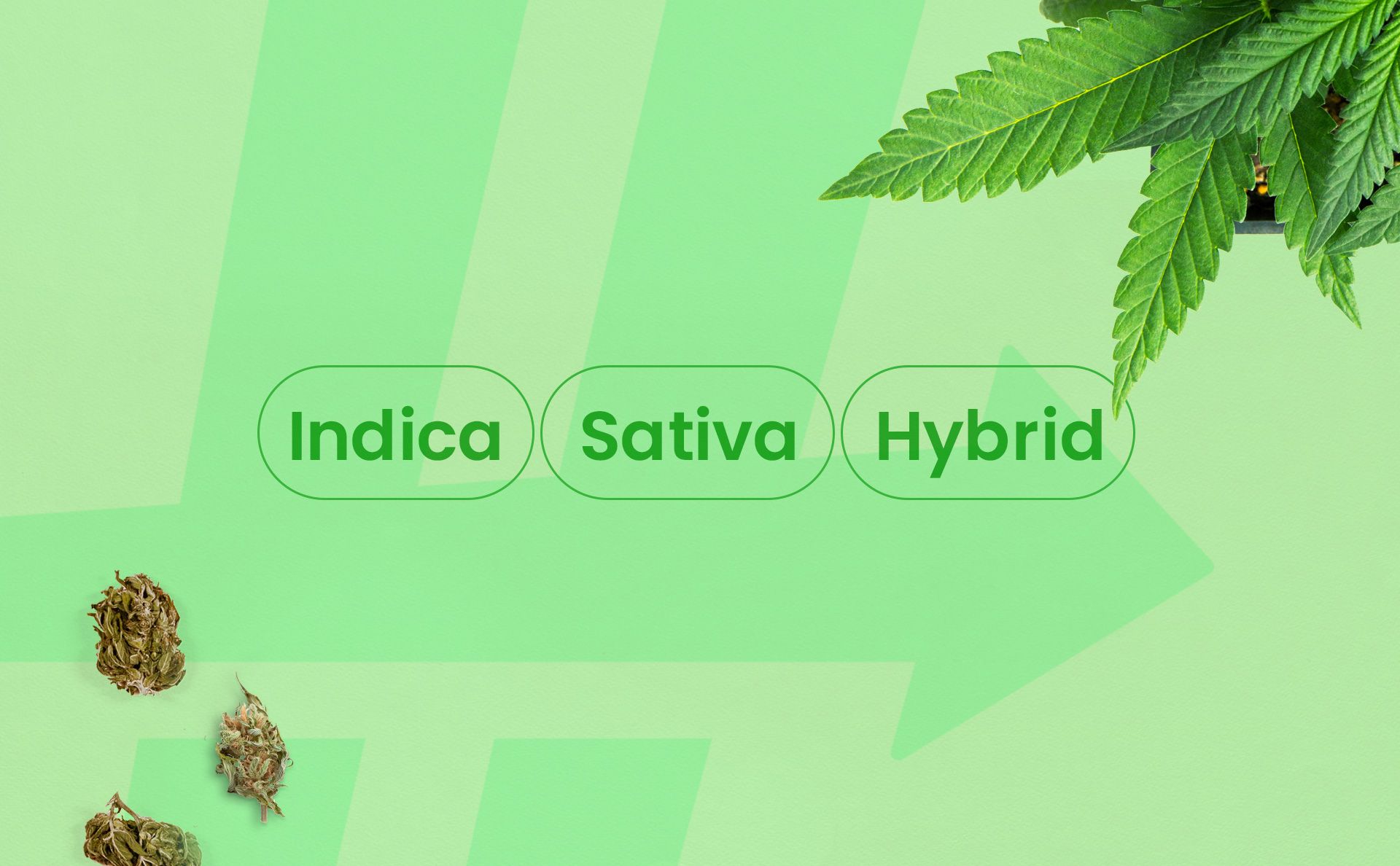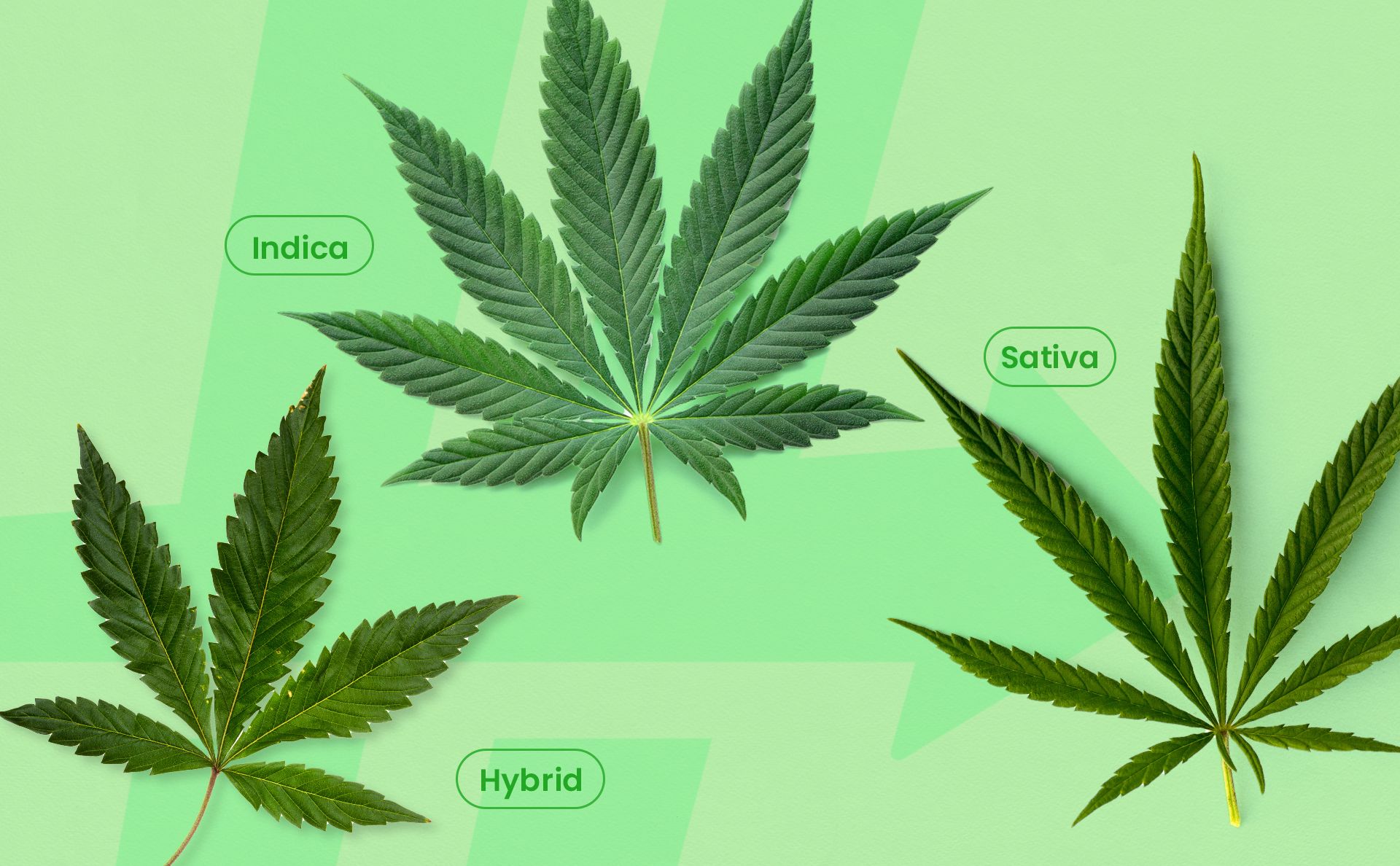Indica vs Sativa vs Hybrid
Wondering what the terms indica vs sativa vs hybrid mean? This chapter educates you on the origins of these three terms, their differences in plants and effects, and more.

When it comes to choosing the right cannabis for you, the indica VS sativa vs hybrid question is the first one to ask yourself. In this chapter, we discuss the origins of the names, the differences between the plants and their supposed effects, and why science currently tells us there’s likely little or no difference in the effects of the two. Also, we briefly touch upon the lesser-known variety of cannabis called ruderalis. Keep reading to get your questions answered.
Terminology Origins
Even the most inexperienced cannabis consumer will be familiar with the terms indica and sativa. But where did these come from? The term sativa was first used by Swedish botanist Carl Linneaus in the mid-1700s.
Linnaeus used Sativa to describe hemp plants grown in Europe and western Eurasia. People in those cultures cultivated what we now know as hemp for the plant’s nutrient-rich seeds and durable fibers.
Towards the end of the 1700s, The French naturalist Jean-Baptiste Lamarck named plants indica after discovering them in India. People in India also grew cannabis for their seeds and fiber. The difference was that people in India made hashish out of cannabis flower.
The interesting part about this is that hash was not only the first cannabis concentrate, it was the first widely consumed form of cannabis. Up until the 1960s, hashish consumers considered the dried and cured cannabis flower to be a crude form of smoking.
Cannabis Ruderalis
Most cannabis consumers have no doubt heard of Sativa and indica, but not too many know about cannabis ruderalis. There has been a debate amongst botanists and growers as to whether cannabis ruderalis qualifies as its own species or subspecies. The botany term ruderal refers to a species of plant that grows despite human modification or changes to its environment.
Cannabis ruderalis is native to northern Asia, Central/Eastern Europe, and specifically, Russia. Ruderalis plants survived the harsh conditions and shorter growing seasons of these areas. Many botanists and cannabis breeders believe that this is where indica originally comes from.
Ruderalis plants are much shorter than their relatives, with most plants being under two feet tall. The stems are thick and sturdy, and the buds are thick but small. Buds from ruderalis tend to be very low in potency. The most notable difference is that ruderalis cannabis varieties enter their flowering state automatically based on how mature the plants are.
Indica and Sativa flowering is triggered by the photoperiod, which means its light/ dark cycle. Ruderalis has been bred into modern-day cannabis seeds, which can give us the coveted auto-flowering varieties. Be sure to read up on different cultivar traits in our Phenotypes chapter.
Differences in Plants
Nowadays, both indica and Sativa are used to describe and classify thousands of cannabis cultivars, even though this classification dichotomy is lacking and is likely incorrect, or at least not entirely accurate. The two terms, at least for now, describe the differences between the two plants. Modern-day indica plants have short, stout stems with broad leaves. Modern-day Sativa plants are tall with narrow leaves.

With so much cross breeding and advancement in growing, there are few purely Sativa or indica cultivars. Much of this cross-breeding was historically done underground to evade law enforcement. The vast majority of cannabis consumed today is a hybrid of the two, and no measurement system can tell us how much of the two a particular cultivar contains. For instance, when you see a cultivar being presented as 60% Sativa, and 40% indica, that is speculation and estimation.
Indica VS Sativa: Effects
What are the differences in effects after consuming indica and Sativa? The common school of thought is that indica-dominant cannabis has a calming, pain-relieving, and sedative effect, while Sativa varieties cause an uplifting and energetic high.
Every cultivar is uniquely different and so is the effect of cannabis on an individual. One person could be put to sleep by a so-called Sativa-dominant cultivar, while another could feel energized by a so-called indica. The way any kind of cannabis will make someone feel is based mostly on the cannabinoid and terpene content of the cultivar, the consumer’s unique biology, and how much they consume.
These effects will vary depending on your consumption method and the quality of the product you’re consuming. These factors will have more of an impact on how you feel the effects of a cultivar than if it is labeled as an indica or a Sativa. For more information about Consumption Methods, be sure to check out our guide on the topic.
Indica VS Sativa: Science Says No Real Difference?
While some cannabis lovers might be surprised by this, scientific research tells us that there isn’t that much of a difference in the effects of indica or Sativa. Yes, this goes against much of what old-school cannabis consumers understand about the plant. However outdated and less than accurate it may be, the Sativa/ indica dichotomy classification is currently the standard in the cannabis industry.
As the science indicates, the experience you get from cannabis cultivars is currently anecdotal and perhaps even has a placebo effect. When researchers started testing cannabis on a molecular level, the results show that the only reason to classify cannabis into the two has to do with the plants themselves. In the 18th century, the classification system we know was started, splitting cannabis plants up into two species as a way to describe their appearance.
What we think of as indica plants need different growing requirements sativa does. The fact that the science says there is not much of a difference could also be largely due to the difficulty of testing how much indica or Sativa a specific cultivar of cannabis contains.
Future Cannabis Classification Systems
Perhaps we will eventually get some more peer-reviewed, definitive evidence of the differences in the effects of indica and Sativa. Or even better, as the cannabis industry continues to grow and evolve, we will develop a more accurate classification system.
We believe that this classification system will be based on key factors like:
- Terpene Content
- TAC (Total Active Cannabinoids)
- Lineage (Parent Cultivars)
The way we classify and understand cannabis is complex and confusing largely because growing the plant has been done underground for so many years. However, you are gaining valuable knowledge of this dynamic and complex cannabis plant by reading HashDash’s Guides for the Canna-Curious. Be sure to continue gaining that knowledge in our other chapters.
What We Learned: Indica vs Sativa vs Hybrid
Although the current classification system does leave a bit to be desired, it is important to understand the differences and similarities between Indica vs Sativa vs Hybrid. Here are key takeaways from the Indica vs Sativa vs Hybrid Chapter:
- Towards the end of the 1700s, The French naturalist Jean-Baptiste Lamarck named plants indica after discovering them in India.
- The botany term ruderal refers to a species of plant that grows despite human modification or changes to its environment.
- Cannabis ruderalis is native to northern Asia, Central/Eastern Europe, and specifically, Russia.
- Modern-day indica plants have short, stout stems with broad leaves. Modern-day Sativa plants are tall with narrow leaves.
- The common school of thought is that indica-dominant cannabis has a calming, pain-relieving, and sedative effect, while Sativa varieties cause an uplifting and energetic high.
- All consumers are different, and each cultivar can make you feel different effects from what others feel.
- We hope to see a more accurate, science-based cannabis classification system as our industry evolves.
You have completed the Cannabis Plant Guide! You’re now educated on all of the Parts of the Plant, How to Grow Cannabis at Home, Trichomes, Phenotypes, and Indica vs Sativa vs Hybrid. Well done.
Ready for another guide? We have many hours' worth of valuable cannabis educational content you can utilize to build your knowledge of this amazing plant and ultimately help enhance your consumption experience.
Citations
- UCLA Cannabis Research: Indica and Sativahttps://www.uclahealth.org/cannabis/default.cfm?id=1
- Cannabinoids Journal: That Which We Call Indica and Sativahttps://bedrocan.com/wp-content/uploads/2014-that-which-we-call-indica-by-any-other-name-hazekamp-erkelens.pdf
Test your knowledge, track your progress and earn your badge.
There isn’t that much of a difference in the effects of indica or Sativa.